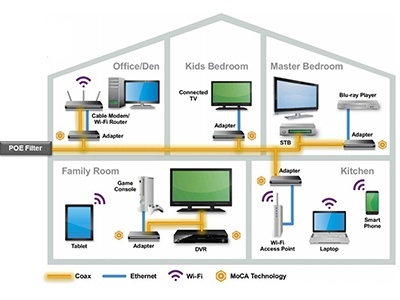Whole home DVR installations can be tricky; MoCA filters are essential to prevent the DVR signals from emanating to neighbors' homes in coax systems. Due to the high output power of these MoCA signals, they can escape from the intended subscriber and enter into other homes that may not want to watch, or may even be offended by the program you are "broadcasting" from your DVR.
This can be a big problem.
MoCA filter placement
Not only is it important to have this filter prohibit signals from leaving your property, but it is equally important to place the filter in close proximity to the home network input. It is suggested that the filter is very close to the point of entry into the home. The port on the multi-tap at the telephone pole is not recommended as a filter installation location; it is not close enough to the home’s point of entry. While the filter prohibits signals from leaving the home, it also electrically reflects signals back into the home, augmenting the in-home signal. So the closer the reflection is to the home, the better.

Addressing passive loss issues
The high output power of the DVR’s MoCA signal is intended to overcome passive loss within the home network. When we think about the DVR signals going from the DVR to a client, the signals will need to jump across splitter outputs. Signals also need to reflect off of the nearby MoCA filter to return with adequate signal level.
The further from the house the filter is placed, the more loss will be induced and lower signal strength will return to the client devices. So placing the filter at the tap can lead to higher passive loss within the home network exceeding the MoCA loss budget, thereby reducing data rates and degrading service or causing service loss entirely.
So bring it back home
Integrating MoCA technology into the network is a nice revenue stream and when installed correctly keeps ALL subscribers happy.



